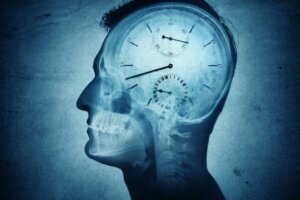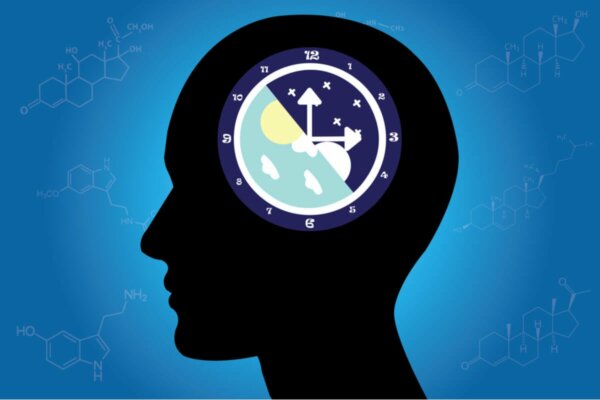Chronobiology and Its Impact in Humans

A new discipline called chronobiology is quickly gaining momentum. It’s about natural cycles and their relationship with body functions. You may not be aware of it but there are natural cycles like day and night and seasons. In short, many periods specifically pertaining to time. This aroused the interest of a group of scientists who wanted to understand the relationship between these cycles of time and the functioning of the human body. As a result, a new discipline called chronobiology has born.
This new discipline wants to relate natural cyclical processes with biological ones in human beings. How does working night shifts affect the health of a person? Why is it important to have set meal schedules? Chronobiology can answer all these questions.
“Biological clock? I don’t even own a watch.”
-Sarah Mlynowski-

Defining chronobiology
Chronobiology is a word derived from three Greek terms: Kronos for time, bio for life, logos for study. This leads to understanding it as a scientific field that studies the synchronization processes in living organisms at different levels of a given organization. Interdisciplinarity takes center stage in it, studying the laws of occurrence of vital processes in time.
In essence, it studies biological rhythms or cyclical variations in the intensity and character of biological processes and phenomena. These rhythms are oscillations whose minimum and maximum values occur at approximately equal time intervals. Furthermore, they generate predictable and regular changes over time. Thus, it explores practical problems, such as the effects of winter or summer schedules and problems associated with sleep, among others.
Even so, it’s important to emphasize that this scientific field isn’t related to “biorhythms”. People base these on an individual’s date of birth. With this, they tried to explain human behavior without any scientific foundations.
Cycles within chronobiology
At present, chronobiology has reliable mathematical procedures that allow the establishment of parameters that characterize biological rhythms. Period, frequency, and fitness are among the main ones.
To make the classification, several criteria can be taken into account, which leads us to have different types. There are mainly two types of biological rhythms according to Lantero (2001).
The first is related to the periodic oscillations of external factors.
- Inert. These operate with their own program.
- Labile. When the external environment influences the viability and development of the organism.
The second of them pertains to the duration of the period in time:
- Circatidal. The period has an approximate duration of 12.4 hours.
- Circadian. This period lasts approximately 24 hours.
- Circannual. Lasts one year.
- Circaseptan. The duration of this cycle is seven days.
- Circatrigintan. This is a period of approximately 25 to 30 days.
There’s a simpler and more widely used classification, given by García-Maldonado et al. (2011) in which time again takes center stage. There are three different cycles, according to him:
- Circadian. This lasts 24 hours and pertains to anything related to day and night.
- Ultradian. This one lasts less than 24 hours and, thus, its frequency is usually high.
- Infradian. This one happens when the period lasts more than 24 hours, and the frequency is lower.
While it’s true that these various biological rhythms exist, the circadian cycle is the most studied so far. This is mainly due to the ease of studying this cycle due to the duration and environmental changes.
Rhythms and synchronizers
As mentioned above, the circadian is the most studied cycle due to its ease. The best known are body temperature, wake-sleep cycle, growth hormone secretion, blood flow, elimination of drugs, among others. It’s important to clarify that all these rhythms interrelate through a complex interdependent hierarchy. In addition, chronobiology shows that rhythms oscillate from one frequency to another. That is to say, they’re not static and depend on external or environmental aspects.
Let’s also emphasize that this organization requires synchronizers, which help in the adaptation to environmental changes and the coordination of biological rhythms. These synchronizers are known as “Zeitgebers” in chronobiology. The main ones are sound, food, light, and temperature.
These generate a balance to develop the processes that take place in the human body. Thus, desynchronization or failure causes discomfort and can lead to the development of diseases.
The brain and chronobiology
Chronology gives prominence to the suprachiasmatic nucleus at the brain level, a structure that houses the “central clock”. Under natural conditions, this structure resets each day mainly by light and darkness, activating ganglion cells.
However, other periodic inputs such as mealtimes and scheduled exercise also influence them. These latter activities activate peripheral clocks that have an important influence on the heart, pancreas, and adipose tissue, among others.

The relationship of chronology with various diseases
The alterations in the chronobiological machinery create an alteration in the output of rhythmic signals to the organism. These effects occur mainly with night workers or people with various conditions. Researchers found a relationship between tension and blood pressure and the time of day measured. In addition, changes in sleep or eating schedules can influence the development of these and other conditions.
In addition, there’s a relationship between the accumulation of fat and the intake of fats and sugars during the night in obese people. Also, research such as that of Aza (2015) found that the timing of food intake is key to obesity. Specifically, they found that eating at night and fasting during the day manifest with impaired glucose tolerance and decreased leptin (satiety hormone).
As for cancer, symptoms show a rhythm. Thus, the administration of drugs should correspond to it. It’ll lead to better results in the treatment, besides having a decrease in the side effects of the medication. This is because rhythms can affect the absorption, metabolization, distribution, and expression of drugs.
Finally, as you can see, chronology aims to make an association between biological rhythms and their effects on the functioning of the body. This is why taking into account things such as time and environmental factors will be fundamental for the regulation of various processes. It won’t only help in the adaptation and adjustment of needs, but will also collaborate in the prevention of various conditions.
All cited sources were thoroughly reviewed by our team to ensure their quality, reliability, currency, and validity. The bibliography of this article was considered reliable and of academic or scientific accuracy.
- Aza, M. G. (2015). La cronobiología, la alimentación y la salud. Mediterráneo económico, 27, 101-122. https://dialnet.unirioja.es/servlet/articulo?codigo=5207070
- García-Maldonado, G., Sánchez-Juárez, I. G., Martínez-Salazar, G. J. y Llanes-Castillo, A. (2011). Cronobiología: Correlatos básicos y médicos. Revista Médica Del Hospital General de México, 74(2), 108-114. http://www.elsevier.es/en-revista-revista-medica-del-hospital-general-325-articulo-cronobiologia-correlatos-basicos-medicos-X0185106311242397
- Lantero, M. (2001). Cronobiología: Consideraciones para un enfoque terapéutico diferente. Vitae (Medellín), 8(1), 55-61.
- Madrid Pérez, J. A. y Rol de Lama, M. Á. (2015). Ritmos, relojes y relojeros. Una introducción a la Cronobiología. Eubacteria, no 33 (2015). https://digitum.um.es/digitum/handle/10201/45908
This text is provided for informational purposes only and does not replace consultation with a professional. If in doubt, consult your specialist.








